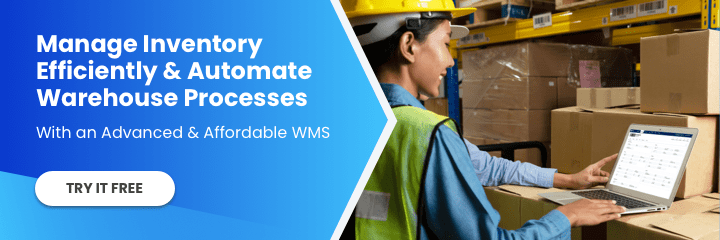In an e-commerce business, managing a fulfillment center with precision is pivotal for business success. Overstocking, or the accumulation of excess inventory, presents a significant hurdle, locking up crucial capital and occupying essential space. Yet, this challenge can be converted into a profitable opportunity with a strategic approach.
This article will provide expert tactics to fine-tune your inventory levels, diminish wastage, and amplify profits, guiding you through converting overstocked merchandise into a valuable asset.
What Causes Overstocking?
Overstocking is a common challenge faced by businesses of all sizes and industries. It occurs when a company holds more inventory than it can sell within a reasonable time frame.

To effectively tackle overstocking, it is crucial to understand the root causes of this problem. Let’s discuss each.
1. Inaccurate Demand Forecasting
One common cause of overstocking is inaccurate demand forecasting. If a company overestimates customer demand, it may produce or purchase more inventory than necessary. This can happen for various reasons, such as relying on historical sales data without considering market trends, underestimating the impact of seasonality or promotional activities, or not considering external factors such as changes in customer preferences or economic conditions.
2. Poor Inventory Management
Another cause of overstocking is poor inventory management practices. Businesses that lack efficient inventory tracking systems or fail to review and update their inventory levels regularly are more prone to overstock situations. This can result in a mismatch between supply and demand, leading to excess inventory.
3. Unexpected Market Changes
Lastly, changes in market trends can also contribute to overstocking. Suppose businesses fail to accurately anticipate shifts in customer preferences or fail to adapt their product offerings accordingly. In that case, they may end up with products that are no longer in demand, leading to overstock situations.
By identifying these causes, businesses can proactively prevent overstocking and ensure a more efficient supply chain.
What is the Problem With Overstocking?
Overstocking can have a significant negative impact on businesses. First and foremost, it ties up valuable capital that could be used for more productive purposes, such as investing in new product development or marketing initiatives. Additionally, overstocking takes up valuable space in warehouses or stores, leading to increased storage costs and reduced operational efficiency.
Moreover, overstocking can increase holding costs, such as insurance, maintenance, and obsolescence expenses, affecting a company’s bottom line. Products left unsold for a long time may become outdated or lose their appeal, making it difficult to sell them at their original price. This can result in significant markdowns or even write-offs, leading to financial losses for the business.
To address the overstocking problem, businesses must adopt effective strategies to clear their overstocked products and turn them into profits. Let’s explore some of these strategies in detail.

Strategies to Reduce Overstocking
Prevention is always better than cure when it comes to overstocking. By implementing the following strategies, businesses can minimize the risk of overstock situations and maintain optimal inventory levels.
1. Effective Inventory Management Techniques
Implementing robust inventory management techniques is crucial in preventing overstocking. Here are some techniques you can implement:
- ABC Analysis
Implementing an ABC analysis can help you prioritize your inventory and allocate resources effectively. Categorize your products into three groups: A, B, and C. Group A should consist of high-value items with low demand variability, Group B should have mid-value items with mid-demand variability, and Group C should include low-value items with high demand variability. By focusing on high-value items, you can ensure efficient inventory turnover and reduce the risk of overstocking low-demand products. - Just-in-Time (JIT) Inventory Management
JIT inventory management aims to minimize inventory levels by receiving and producing goods just in time for customer demand. This approach eliminates the need for excessive stockpiling and reduces holding costs. However, it requires strong coordination with suppliers and a robust logistics network to ensure timely deliveries. Consider implementing JIT principles in your inventory management strategy to avoid overstocking. - Continuous Inventory Monitoring
Regularly monitor your inventory levels to identify potential issues and take proactive measures. Leverage technology and implement real-time inventory tracking systems that provide accurate and up-to-date information. Set inventory thresholds and establish alerts to notify you when stock levels are approaching danger zones. This will allow you to take timely action, such as introducing targeted promotions or adjusting procurement schedules, to prevent overstocking.
2. Implementing a Demand Forecasting System
Accurate demand forecasting is key to preventing overstocking. By analyzing historical sales data, market trends, and customer behavior, businesses can forecast future demand more accurately.
There are several key steps to implementing a demand forecasting system effectively:
a) Gather historical data: Start by collecting historical sales data, customer behavior data, and any relevant market trends. This data will serve as the foundation for your demand forecasting models. Ensure that the data is clean and accurate to avoid skewed results.
b) Select appropriate forecasting models: Depending on the nature of your business and the data available, choose the most suitable forecasting models. Common models include moving averages, exponential smoothing, and regression analysis. Consider using a combination of models to account for different variables and improve accuracy.
c) Evaluate and refine: Once you have implemented your forecasting system, regularly evaluate its performance and refine the models as needed. Compare the forecasted values with actual sales data to identify any discrepancies. Adjust the models accordingly to improve accuracy over time.
By implementing a demand forecasting system, your business can make informed decisions about inventory replenishment, production planning, and order fulfillment. This can significantly reduce the risk of overstock situations by ensuring that businesses have the right inventory at the right time.
Advanced forecasting techniques such as predictive analytics and machine learning can further enhance the accuracy of demand forecasts. By analyzing large datasets and identifying hidden patterns, businesses can make more accurate predictions and prevent overstocking.
3. Utilizing Discounts and Promotions to Clear Overstock
When faced with overstocking, implementing targeted discounts and promotions can clear your stock quickly and generate revenue. Here are some strategies to consider:
- Flash sales: Create a sense of urgency by offering limited-time discounts on your overstocked products. Promote these flash sales through various channels, such as email marketing, social media, and your website. Highlight the limited availability and emphasize the savings customers can enjoy. This will entice customers to make a purchase and help clear your overstock.
- Bundle deals: Create attractive deals by combining overstocked items with popular or complementary products. Offer these bundles at a discounted price to incentivize customers to purchase more. This strategy helps clear overstock and encourages customers to explore other products in your inventory.
- Tiered discounts: Implement tiered discount structures based on the quantity purchased. For example, offer a 10% discount for one item, 20% for two items, and 30% for three or more items. This encourages customers to buy more and helps clear excess inventory. Display the tiered discounts prominently to capture customers’ attention and motivate them to make larger purchases.
By utilizing discounts and promotions, you can create a sense of urgency, generate customer interest, and clear your overstock effectively. However, it’s important to carefully calculate your profit margins and ensure that the discounts offered are profitable for your business and do not devalue the brand.

4. Leveraging Online Marketplaces and E-commerce Platforms
In today’s digital age, online marketplaces and e-commerce platforms offer great opportunities for businesses to reduce overstocking. Here’s how you can leverage these platforms to your advantage:
- List on popular online marketplaces: Take advantage of well-established online marketplaces, such as Amazon, eBay, and Etsy, to reach a wider audience and clear your overstock. These platforms attract millions of potential customers, increasing your chances of finding buyers for your overstocked products. Optimize your product listings with appealing visuals, compelling descriptions, and competitive pricing to stand out.
- Leverage social media: Utilize social media platforms, such as Facebook, Instagram, and Twitter, to promote your excess inventory. Create engaging posts and share enticing visuals to attract attention. Consider running targeted ads to reach specific customer segments interested in your products. Encourage social sharing and user-generated content to increase visibility and generate buzz around your overstocked items.
- Build your own e-commerce website: Establishing your own e-commerce website gives you full control over your inventory and customer experience. Create a dedicated section for your overstock and optimize the product pages for search engines. Implement effective SEO strategies to increase organic traffic to your website. Offer special incentives, such as free shipping or exclusive discounts, to entice customers to purchase.
5. Partnering with Liquidation Companies
If all else fails, partnering with liquidation companies can be a viable option to clear overstock. These companies specialize in purchasing large quantities of surplus stock and selling them to secondary markets. Here’s how you can approach this strategy:
a) Research reputable liquidation companies: Conduct thorough research to identify reputable liquidation companies that align with your industry and target market. Look for companies with a track record of fair business practices and a strong network of buyers. Check for reviews and testimonials from other businesses that have worked with them.
b) Negotiate favorable terms: Reach out to the liquidation companies and negotiate favorable terms for selling excess inventory. Discuss pricing, quantity, and additional services they may offer, such as inventory transportation or product disposal. Ensure that the terms are mutually beneficial and that you receive a fair product price.
c) Ensure legal compliance: Before finalizing any agreements, comply with any legal requirements and regulations related to selling your overstocked items to liquidation companies. Familiarize yourself with any restrictions or guidelines that may apply to your industry or specific products.
Conclusion
Overstocking may seem like a daunting challenge, but with the right strategies, it can be turned into a profitable opportunity. By implementing effective inventory management techniques, leveraging discounts and promotions, utilizing online marketplaces, and partnering with liquidation companies, businesses can clear their overstocked products and maximize their profitability.
Remember, prevention is key. By accurately forecasting demand, optimizing inventory levels, and monitoring market trends, businesses can avoid the accumulation of excess inventory in the first place. With a proactive approach and a focus on efficient inventory management, you can transform your overstocked products into a goldmine of profits.
For more content about warehouse efficiency or the latest technology trends, follow us on LinkedIn, YouTube, X, or Facebook. If you have other inquiries or suggestions, please contact us here.
- SEO Powered Content & PR Distribution. Get Amplified Today.
- PlatoData.Network Vertical Generative Ai. Empower Yourself. Access Here.
- PlatoAiStream. Web3 Intelligence. Knowledge Amplified. Access Here.
- PlatoESG. Carbon, CleanTech, Energy, Environment, Solar, Waste Management. Access Here.
- PlatoHealth. Biotech and Clinical Trials Intelligence. Access Here.
- Source: https://articles.cyzerg.com/overstocking-effective-strategies-to-avoid-it-and-boost-profits






